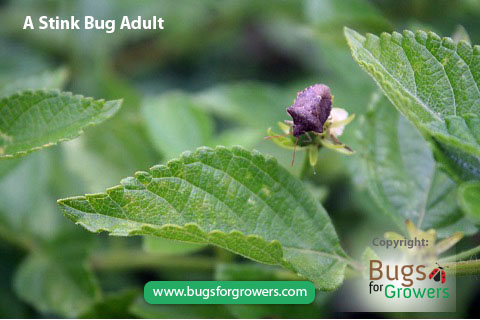Description:
Stink bugs are called “true bugs” because they belong to an insect order Hemiptera, and have piercing and sucking type of mouthparts. They are named as stink bugs because they emit a pungent odor when disturbed. There are several species of stink bugs occur in the nature but the most commonly known species including the green stink bug (Acrosternum hilare), the southern green stink bug (Nezara viridula), the brown stink bug (Euschistus servus) and the brown marmorated stink bug (Halyomorpha halys) are considered as economically important pests of many crops. These insects are polyphagous pest meaning they feed on over 50 plant species that may include many field crops (alfalfa, beans, cabbage, corn, cotton, okra, peas, soybeans, squash and tomatoes), ornamental plants, fruits (citrus and peach) and weeds.
Biology:
The life cycle of all the species of stink bugs consists of egg, nymph and adult stages. Nymphs develop through five stages (instars) and become adults, which are shield-shaped (photo 1). Stink bugs overwinter as adults and become active early in the spring when temperature rise above 20oC (68oF). Females of different species of stink bugs generally lay eggs with different shapes and colors. Depending on the species, nymphs and adults of stink bugs can be green or brown in color with species specific colored blackish, brownish, reddish or whitish markings of their bodies. All the nymphal stages generally look like adults but they are wingless and comparatively smaller in size.

Damage:
Both nymphs and adults cause damage by injecting toxic substances into plant cells, and by sucking cell sap from growing shoots and developing fruits and pods. The symptoms of bug damage include withering and dying of injured shoots, deformation and discoloration of fruits and seeds inside the pods.
Control:
Control of stink bugs is essential for the normal developments of both fruits and pods. Chemical pesticides can be effective in controlling stink bugs but their use should be avoided due to their detrimental effects on human health and the environment. Several natural enemies including birds and both predatory and parasitic insects can suppress the population of stink bugs in the fields. The egg parasitoids including Trissolcus halymorphae (Yang et al., 2009.) and Trissolcus basalis (Liljesthrom et al., 2014) have been found to be effective in controlling various species of stink bugs.
Research papers
- Liljesthrom, G.G., Cingolani, M.F. and Roggiero, M.F. 2014. Susceptibility of Nezara viridula (L.) (Hemiptera: Pentatomidae) egg masses of different sizes to parasitism by Trissolcus basalis (Woll.) (Hymenoptera: Platygastridae) in the field. Neotropical Entomology 43: 78-84.
- Yang, Z, Yao, Y, Oiu, L. and Li, Z. 2009. A new species of Trissolcus (Hymenoptera: Scelionidae) parasitizing eggs of Halyomorpha halys (Heteroptera: Pentatomidae) in China with comments on its biology. Annals of the Entomological Society of America 102: 39-47.
